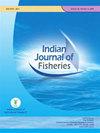Chanos Chanos幼虫不同阶段的氨基酸和脂肪酸组成:对幼虫饲料配方的影响
IF 0.3
4区 农林科学
Q4 FISHERIES
引用次数: 2
摘要
研究了香茅受精卵和不同幼虫期(孵化后0、3、6、9、12、15和21天,dph)的氨基酸(AA)和脂肪酸(FA)组成。总必需氨基酸(IAA)占鸡蛋总氨基酸的55.62%,到第6dh下降到52.54%。chanos的AA图谱富含因瓦蛋白(7.99%)、亮氨酸(7.51%)和赖氨酸(6.98%),而组氨酸(2.36%)和蛋氨酸(2.47%)含量较低,表明缬氨酸、亮氨酸和赖氨氨酸的需求量较高。卵、初孵幼虫(NHL)和21日龄幼虫的二十二碳六烯酸(DHA)含量分别为2.77、1.36和1.94 mg g-1。脂肪酸(FA)在初孵幼虫中的还原率很高,尤其是DHA(51%)、ARA(26%)和EPA(24%),这表明这些脂肪酸在乳鱼卵胚胎发生过程中具有重要意义。在AAs和FAs含量的不同阶段观察到的趋势表明了它们在幼虫期的需求,在为乳鱼幼虫期配制饲料时应考虑这些值。关键词:胚胎发生;幼虫饲料;Milkfish幼虫;营养需求本文章由计算机程序翻译,如有差异,请以英文原文为准。
Amino acid and fatty acid compositions of various stages of Chanos chanos larvae: Implications for larval feed formulation
Amino acid (AA) and fatty acid (FA) composition of the fertilised eggs and different larval stages (at 0, 3, 6, 9, 12, 15 and21 days post-hatch, dph) of Chanos chanos was investigated. The total indispensable amino acids (IAA) contributed to55.62% of the total AA in the egg which reduced to 52.54% on 6 dph. The AA profile of C. chanos was found to be rich invaline (7.99%), leucine (7.51%) and lysine (6.98%) and poor in histidine (2.36%) and methionine (2.47%), indicating a highvaline, leucine and lysine requirement. The docosahexaenoic acid (DHA) content recorded for egg, newly hatched larvae(NHL) and 21 dph larvae were 2.77, 1.36 and 1.94 mg g-1, respectively. The reduction of fatty acids (FAs) was found to bevery high in newly hatched larvae (NHL), especially that of DHA (51%), ARA (26%) and EPA (24%), which indicates thesignificance of these FAs during the embryogenesis of milkfish egg. The trend observed during different stages of AAs andFAs content indicates their requirement during the larval period and those values are to be considered while formulatingfeeds for larval stages of milkfish.
Keywords: Embryogenesis, Larval feed, Milkfish larvae, Nutrient requirement
求助全文
通过发布文献求助,成功后即可免费获取论文全文。
去求助
来源期刊

Indian Journal of Fisheries
FISHERIES-
CiteScore
0.90
自引率
20.00%
发文量
0
审稿时长
6-12 weeks
期刊介绍:
Indian Journal of Fisheries is published quarterly by the Indian Council of Agricultural Research (ICAR), New Delhi. Original contributions in the field of Fish and fisheries science are considered for publication in the Journal. The material submitted must be unpublished and not under consideration for publication elsewhere.
Papers based on research which kills or damages any species, regarded as thratened/ endangered by IUCN crieteria or is as such listed in the Red Data Book appropriate to the geographic area concerned, will not be accepted by the Journal, unless the work has clear conservation objectives.
 求助内容:
求助内容: 应助结果提醒方式:
应助结果提醒方式:


